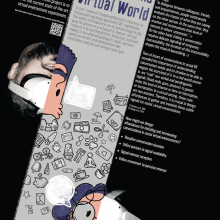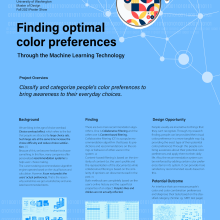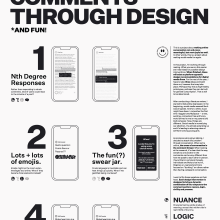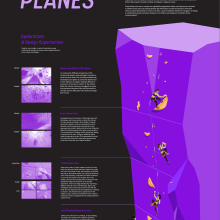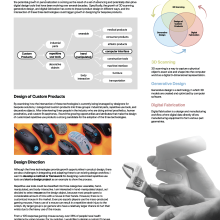Eight Master of Design students are working towards graduation in June 2022. In mid-December, they shared their current thesis work in an online session, and they are now ready to share that further.
Julian Body
- Title: Deconstructing the Hype: Interacting with the Abstract to Empower Sneakerheads
- Chair: Kristine Matthews
The impact of sneaker culture has become undeniable: the approximate value of the industry approaches $79B, with 80% growth projected over the next decade. In recent years, the perception of scarcity and desirability of sneakers from consumers defines a growing number of releases. In fact, the abstract interplay with hype increasingly defines most sneaker enthusiasts’ relationship to footwear. How might consumers engage in a nuanced conversation with this phenomenon? Documenting the trajectory of sneaker hype in the 21st century, this thesis considers how consumers find greater meaning and divergence from the machinery of hype and the implications of this beyond footwear.
Read more in Body's Medium post.
Erfan Dastournejad
- Title: Actual Conversations for the Virtual World
- Chair: Axel Roesler
The advent of the metaverse and its cascading effect in the tech industry and consequently pop culture provides a wide variety of opportunities for designers. Social virtual reality (VR) became my main interest in this field. People join these virtual spaces with their customized/personalized avatars and usually have conversations. In some senses, it is very similar to any other social settings. However, the whole “virtualness” of the interactions brings novel possibilities for research and development. My thesis project hypothesizes ways to improve the initiation and termination of conversations in VR. Then uses hi-fi prototypes to test and measure their success.
Read more in Dastournejad's Medium post.
Sooji Kim
- Title: Finding optimal color preference — Through Machine Learning Technology
- Chair: Sang-gyeun Ahn
We are surrounded by a multitude of options every day; because of this, we become hesitant in our-decision making. Accordingly, many companies offer personalized recommendation systems using AI technology to help consumers’ choice making. However, the existing algorithm recommendations operate based on the product’s visual factors and mathematical calculations. This means the system omits the user’s actual preference, often leading to unsatisfactory and unrelated recommendations. This thesis project will focus specifically on tangible ways to classify people’s color preferences, bringing confidence to choices related to interior design. Through Clustering, a primary machine learning technology, this project will classify common interior design styles and integrate individuals' interior design preferences so that they can make design decisions easier.
Read more in Kim's Medium post.
Andy Madrick
- Title: Meaningful (and fun!) Comments Through Design
- Chair: Karen Cheng
Comment threads are digital, micro-town hall meetings in which anyone can voice an opinion, argue with strangers, or yell into the void. Comments can inject value into our online experience, but they just as often contribute to a meaningless and/or hostile online ecosystem. The goal of this thesis is to create designed objects that encourage a sense of meaning in online conversation. Specifically, I will be working through “design interventions”, or small-scale design solutions, focused on increasing nuance, logic, civility, and process–orientation in comment threads. When completed, these interventions will exist as platform agnostic design recommendations for social media firms.
Read more in Madrick's Medium post.
Rebecca Rhee
- Title: Shifting Planes: Vertical Wayfinding through Augmented Reality Assisted Navigation
- Chair: Axel Roesler
Whether it's a familiar or unfamiliar environment, wayfinding consists of a few simple steps: setting a destination, method of travel, arrival at the destination and a path to return. Rock climbing expands upon these steps and adds further complexities to our relationship with navigation. Climbing is a sport that involves solving challenging and sometimes undefined routes while dynamically moving the body. These multi-layered intricacies of the physical sport lends a space to consider augmented and virtual wayfinding beyond the horizontal plane. This thesis aims to study the techniques climbers utilize to complete routes and the various frictions to expand how navigation within Augmented and Virtual Reality could be designed for intricate environments. The thesis also explores various methods through visual, audio, and tactile experiments.
Read more in Rhee's Medium post.
Stephanie Tang Waldrop
- Title: Encoded Behaviors: Gendered cognitive labor patterns in home assistant technologies
- Chair: Audrey Desjardins
Cognitive labor is the thinking aspect of labor, and in the context of the home, consists of managing + delegating household tasks. Research on cognitive labor concludes that this labor falls on gendered lines where women continue to bear a majority of domestic housework despite the uptick of women in the workforce. Without raising awareness of this facet of labor, gender operates as an invisible mechanism that shapes home behavior patterns and reinforces this household gender gap. Home assistant technologies — like Alexa and Google Home — are trending towards ubiquity in America. As they become more enmeshed in our everyday lives, I believe it is important to critically probe the promises of these technologies. They claim to enhance productivity and human efficiency — not only do they entertain you, provide you with statistics, and keep your home safe — but they also serve as a pathway to domestic harmony, where tackling home labor is easily accomplished by way of machine commandment. My thesis investigates: the gendered cognitive labor dynamic in the home, how these objects reproduce this gendered dynamic, how we might make home assistant technology more useful in aiding one’s cognitive load, and how designers might tackle ways to make cognitive labor visible and tangible.
Read more in Tang Waldrop's Medium post.
Eason Yang
- Title: Designing the gap: Empowering young adult cancer survivors with career-focused social support
- Chair: Annabelle Gould
NED stands for “No Evidence of Disease” (the term used by medical professionals) and “Not Entirely Dead” (an inside joke for cancer survivors). The organization is focused on empowering survivors to return to work with confidence while enabling and educating employers on hiring more inclusively.
Read more in Yang's Medium post.
Zerong Yang
- Title: Bespoke and Repetitive: Converging Technologies in the Design of Custom Products
- Chair: Jason O. Germany



